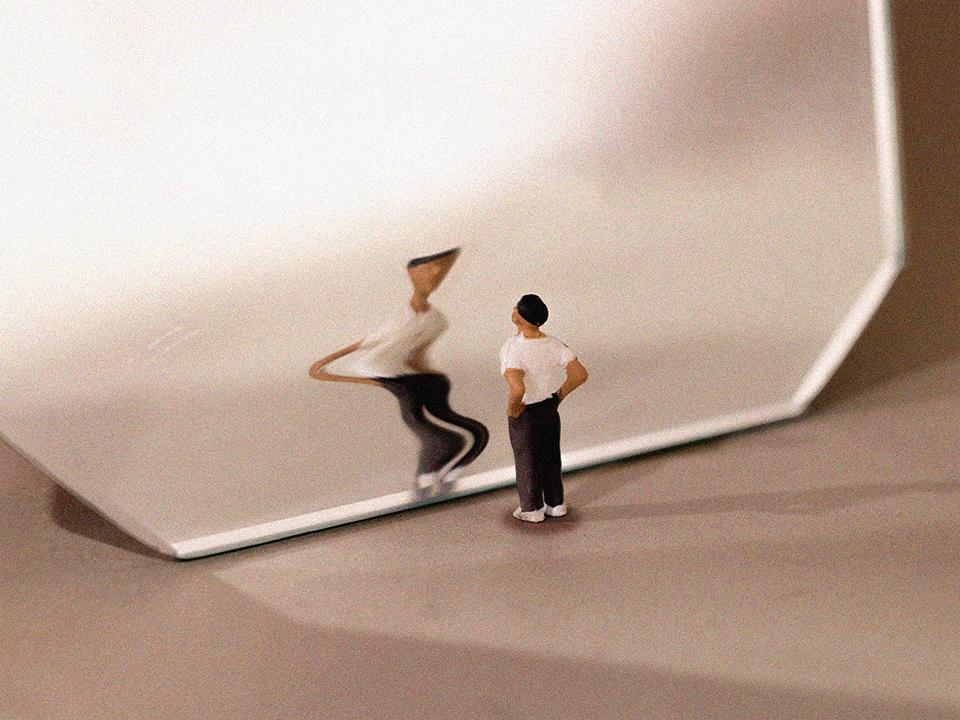5 Things People With Body Dysmorphia Want You to Know
Unfortunately, telling them they look awesome doesn’t help.
When psychotherapist Chris Trondsen, LMFT, started high school, he got acne. To him, those breakouts looked extremely severe. “I just felt like I was kind of a monster, a beast, my face wasn't put together correctly,” he explains. In reality, his skin was like most teenagers' or maybe even clearer. Multiple dermatologists told him his acne was so mild that he wasn’t a candidate for serious acne medication. Years later, he was diagnosed with body dysmorphia, or body dysmorphic disorder (BDD).
People with BDD (about 1.9% of adults) literally see themselves differently than others do. When you live with this condition, the reality of what you look like is distorted.
This mental health condition, which is a type of obsessive-compulsive and related disorder, manifests as intrusive thoughts (called obsessions), per the Diagnostic and Statistical Manual of Mental Disorders (DSM-5-TR). Those often all-consuming thoughts can center around things like your skin, body shape, face, hair, or other physical features. You might even spend up to eight hours a day obsessing over these things, according to the DSM-5-TR. Sure, we've all had moments where we're super aware of and insecure about our appearance, but in BDD these obsessive thoughts are focused on perceived flaws that are either barely noticeable or don't register at all to other people.
To manage or soothe those obsessions, people with BDD do repetitive behaviors (compulsions) that are hard to avoid or feel like the only way to put a pin in those thoughts, according to the DSM-5-TR. That could look like compulsively comparing yourself to others, checking the thing you’re fixated on in the mirror or on your phone, trying to fix or pick at whatever’s bothering you, or repeatedly asking your friends and family for reassurance.
It doesn’t take a psychologist to see that hyper-fixating on imaginary or exaggerated physical deformities messes with your life. Mak D., 25, says that before she was officially diagnosed with BDD in college, her grades dropped and she started isolating at home. She spent nearly all of her free time staring at her thighs and under eyes in the bathroom, crying over how she looked, and texting her friends about her body. “My mental health felt locked inside that bathroom,” she says.
Yep, it can be pretty rough. Whether you have BDD or you want to be there for someone who does, we asked people with the condition to shed light on what Trondsen says is a super misunderstood disorder.
1. It’s not always obvious that someone's struggling.
People might ask you if their cheekbones or hair look weird, but you can’t always tell when they’re dealing with BDD-related obsessions or compulsions. You might be at the movies with a friend who can’t stop mentally comparing their body to your body the whole time, says Mak D.
Mak D. also hid a lot of what she was struggling with from people by staying home and telling friends she was sick on the weekends. They’d assume she was studying during lunch when she was actually in front of a big locker room mirror she knew no one would be using.
2. People with body dysmorphia really do see themselves differently.
Like we mentioned earlier, body dysmorphic disorder is way different than just wanting to look good or disliking some part of your face or body. “We see it as deformed or odd or weird-shaped [when it’s not],” Trondsen says.
Tammy R., 53, started feeling this uncontrollable need to fix her teeth, nose, and jaw in her late 20s. To her, they were significantly deformed. “Thoughts wake you up in the middle of the night, and you've got to go to look at yourself in the mirror. And what you look at in the mirror is just so terrible,” she says. “You're not seeing anything else about you or anything about who you are. You just see this defect.”
Stephanie T.*, 33, who got a BDD diagnosis two years ago, says she obsesses over a part of her face that, to her, looks much smaller than it used to because of a medically necessary surgery. “While some people say they see a slight difference, many others say they do not, and no one thinks it’s nearly as bad as I think,” she says.
It would be awesome if you could just snap out of the distorted way you see yourself with BDD, but this obsessive-compulsive kind of mental health condition isn’t easy to shake. “I think people who have never struggled with BDD assume it’s like a light switch you can just turn off,” says Stephanie T.
There’s no easy fix or moment of clarity though. “This preoccupation with our looks is usually so deeply ingrained in us that it takes a lot of time and self-work to see things differently and obsess less over our so-called flaws,” Stephanie T. adds. “My therapist tells me I always see ‘the part for the whole’ when I look at myself. If one feature isn’t as perfect as I want it to be, it means I’m all bad, I’m worthless.”
3. Body dysmorphic disorder isn’t an eating disorder.
You might’ve heard that people with eating disorders, like anorexia nervosa, can see themselves as much bigger than they are, but that’s not the same thing as BDD, explains Trondsen.
That misconception could be part of the reason why some of Trondsen’s clients with BDD were first misdiagnosed with an eating disorder. But unlike disorders like anorexia, people with BDD are mainly concerned with the structure of their face or body, says Trondsen. They might think their calves are too small, their hips are too wide, or their features aren’t symmetrical, he explains.
Though it’s totally fair if you were confused, knowing the difference can help you spot the signs of BDD in people you care about and maybe even help them find some professional support. It can also help you avoid topics that might be triggering for your friend or coworker with BDD. For example, you might steer away from discussing how someone looks (them or anyone else), especially from the neck up, says Trondsen.
For what it’s worth, you can be diagnosed with both BDD and an eating disorder—it’s something Trondsen sees in his clients quite a bit. And sometimes people will change how they eat because of BDD. For example, Trondsen says he completely gutted how he ate based on things he read could cause breakouts.
4. Compliments don’t help.
Even though you might have good intentions, telling someone with BDD you don’t see what they see or that they look great doesn't make much of a difference. “No matter how many people I love and trust reassure me it’s fine, I’m the only person who can really convince myself otherwise,” says Stephanie T., who is working on that in therapy.
Getting reassurance is also just a temporary fix, says Trondsen. He’d ask his mom if his face looked extra red in certain lighting or if his skin was clear, but her answer was never good enough. He’d feel calm for a little while, then go right back to fixating, he says. Or he’d think that people were only giving him compliments because they saw how bad he looked and felt sorry for him. Trondsen sees this in his clients with BDD too. They’ll think their friends and family are lying to make them feel better, he says.
Julia, 32, who was diagnosed with BDD during her freshman year of college, says that validating her feelings is more helpful than giving her compliments. You could say something like, "I know you're having a hard time, and I’m sorry you’re going through it," and then help them think about non-appearance things they rock at, she suggests. Maybe bring up the good advice they gave you the other day or that you’re jealous of how funny their Instagram captions are.
5. The physical “flaws” may be unfixable, but there is help for BDD.
In his clinical experience, Trondsen says people with BDD who seek out surgeries or treatments often think they look worse or become preoccupied with another area of their body afterward. It can be very depressing, he says.
Working with a mental health professional is what’s actually helpful for people with BDD. “The problem is not in your face. It’s in your mind,” notes Tammy R., who says she was horrified seeing the results of plastic surgery she got years ago.
Cognitive behavioral therapy (CBT) helps challenge beliefs about the body parts people with BDD are obsessing over, Trondsen explains. Therapists can also help them practice doing real-life things without their compulsions. For example, someone who’s convinced they’re balding and wears hats all the time might go to therapy without their head covered, then work up to going to the store hatless, he says.
“Through CBT, I learned that I am someone that people like and want to be around. ... We worked through the shame and guilt I had about my appearance and myself,” Trondsen says. “Recognizing that these feelings were from the disorder, not my organic thoughts, helped me let go of those emotions.”
Along with therapy, SSRI medications can ease anxiety and depression symptoms and also quiet ongoing negative thoughts about the body, says Trondsen. Both therapy and meds helped with Tammy R.’s nonstop intrusive thoughts, panic attacks, and depression she felt because of her BDD. Meditating, journaling, and working out has also helped her. You know...stuff that’s good for your mental health. “It was a lot of self-work, and it continues to be,” she says.
*Name has been changed.
Wondermind does not provide medical advice, diagnosis, or treatment. Any information published on this website or by this brand is not intended as a replacement for medical advice. Always consult a qualified health or mental health professional with any questions or concerns about your mental health.




